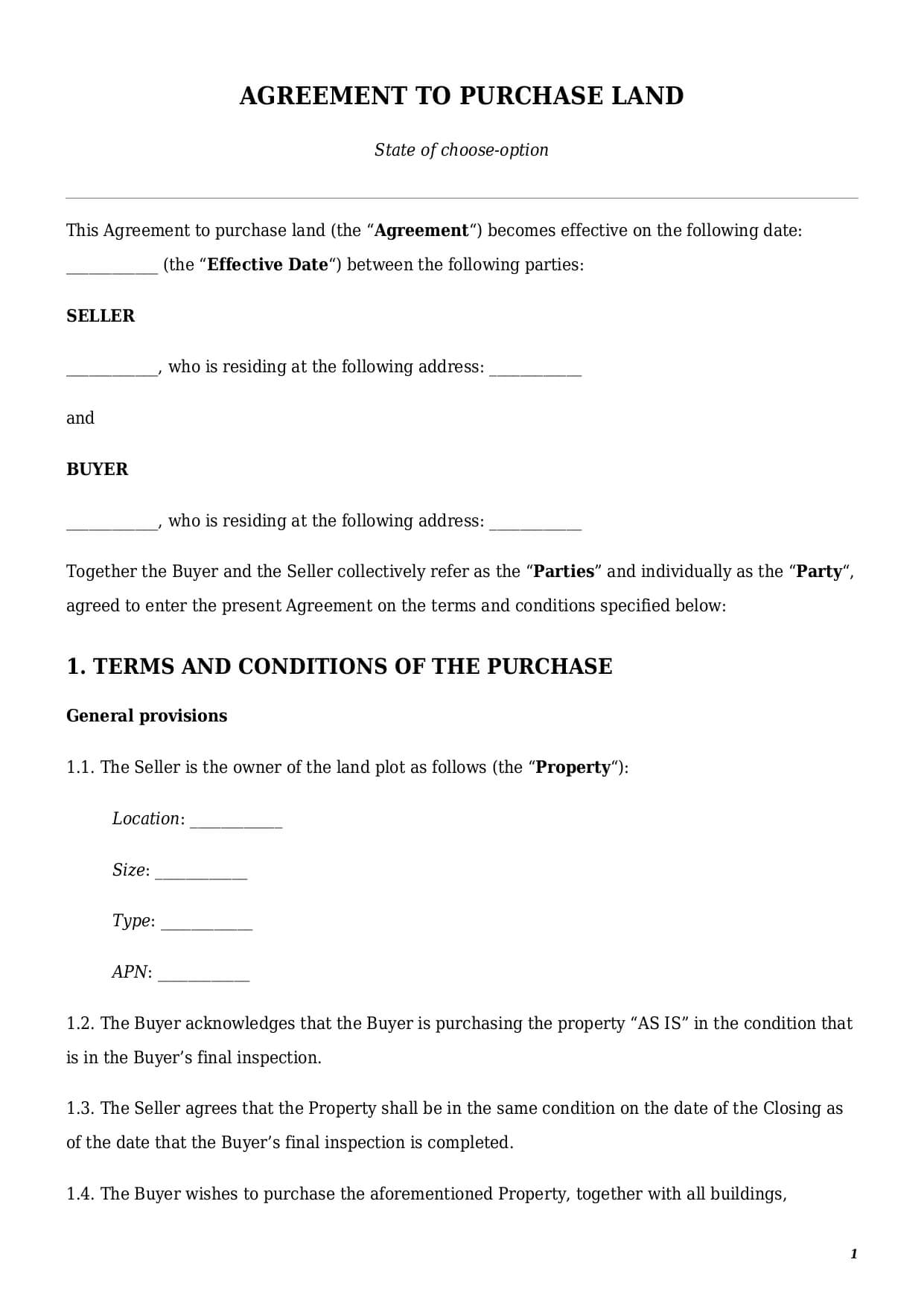Agreement to Purchase Land
Reviews


What is an agreement to purchase land?
A land purchase agreement is a legally binding contract used when transferring ownership of a land plot from a seller to a buyer. It defines the terms and conditions of the transaction as well as clear obligations for both parties. A land sale contract defines:
- full details of the parties;
- purchase price and other payment terms;
- details about the land plot;
- closing procedures;
- financing terms;
- post-closing obligations of the parties.
The parties to a land sale purchase agreement are the seller and the buyer. The seller is a land plot’s owner who wishes to sell it. The buyer is a person that wishes to acquire such a land plot and pay the agreed price for it. The parties to the present contract could be both individuals or legal entities. The real estate market in the United States is open to foreign individuals and companies as well. That means that any overseas buyer or seller can acquire the land in the United States without additional restrictions.
The present land purchase agreement contract could be suitable for an ownership transfer in various transactions:
- private sale between individuals;
- real estate investment for a business or a family;
- acquisition of land for further development (e.g., rural or agricultural) and many more.
How to draft a land purchase agreement template?
A comprehensive land sale agreement form shall include a number of critical sections to be valid and enforceable. Below we prepared a breakdown of all the key clauses a good land sale agreement should have.
Information about the Parties
Every land purchase agreement form should provide detailed information about the seller and the buyer, including their full legal names, addresses, and contact information.
The parties that are indicated as a buyer and a seller shall sign the contract. If a party is an individual, they should simply put their signature at the end of the contract. If a party is a company, in that case a company’s representative is required to sign such a contract. A company’s representative could be a director, attorney, or a third party acting based on the power of attorney.
Details about the Land Plot
Every land sale agreement should define the land plot’s details, including:
- a land plot’s location (i.e., street address, state, ZIP code);
- size (in square feet);
- type of usage or zoning (e.g., residential, commercial, or agricultural);
- APN identification.
If a land plot has any buildings or fixtures (e.g., a fence or mailbox), a land sale agreement should include their detailed description as well. All the buildings and fixtures attached to the land are transferred to a new buyer without the need to enter a separate deed.
Third Parties’ Rights and Encumbrances
Every land sale purchase agreement must disclose in full all applicable third parties’ rights and encumbrances. There are various types of encumbrances a land plot may have:
- Municipal liens (e.g., unpaid property taxes, utility bills, municipal service charges, etc.);
- Pending court or arbitration proceedings (e.g., a land plot might be subject to existing court proceedings);
- Existing leases or tenancy rights (e.g., a farm lease);
- Utility access rights (e.g., a land plot should provide access to install Internet cable or to connect to public sewer lines, etc.); or
- Mortgage (e.g., a seller acquired a land plot using a mortgage from a bank).
If the seller hides or does not disclose existing encumbrances intentionally, the sale-purchase agreement might become void.
Payment provisions
A good land sale agreement template should define clearly all the payment terms. In particular, the agreement should specify the following:
- total purchase price of the land;
- acceptable payment method (e.g., PayPal, cash, bank withdrawal);
- deposit amount and payment date.
In certain circumstances, a buyer may need to obtain financing (i.e., a loan or mortgage) to make the payment. If this is the case, a land sale agreement template shall additionally include information about:
- name of a bank or financial institution that provides a loan or mortgage;
- conditions on which the loan should be taken (e.g., amount of the loan, annual interest rate);
- period of time for which a seller is ready to wait until the buyer gets the loan (e.g., 30 or 60 days from the date of signing).
Closing Procedure
A land sale agreement format should also include a detailed closing procedure. The parties have to agree on the following essential elements below:
- closing date and closing address;
- details of escrow account;
- proration of taxes and utility responsibilities arising from a land plot’s possession;
- date of a transfer of a land plot’s possession;
- delivery of a deed and title policy.
Rights and Obligations for the Parties
Every land purchase agreement template should define the seller’s and buyer’s obligations. This ensures both parties are aware of their duties under the contract and can control a contract’s proper execution by another party.
Seller in a purchase contract undertakes to:
- deliver a clean and marketable title over a land plot;
- disclose all existing defects, encumbrances, or other third-party rights;
- maintain the land plot in the same condition until the closing date; and
- allow a buyer’s inspection of a land plot prior to the closing date.
The buyer in a land purchase agreement shall:
- perform all payments in full and in a timely manner;
- get financing for the purchase of a land plot on the agreed terms (if applicable);
- make a review of a title and inspect a land plot for possible defects.
The list of obligations mentioned above may include other additional duties depending on the nature of the transaction and peculiarities of a land plot in question.
Top 5 Common Mistakes When Drafting a Purchase Agreement for Land
Lack of property descriptions
A land plot is the subject of a sale-purchase contract and thus constitutes its core element. Without identifying a land plot, parties may encounter negative legal consequences in the future. Amongst negative consequences are troubles with a conveyance deed registration or even a document’s invalidity.
In order to avoid that, parties have to make sure that they include accurate information. The best way to do that is to take information about the land plot from official sources only, including:
- country ‘assessor’s property record;
- existing title deed;
- property tax assessment notice; or
- mortgage contract (if applicable).
A complete property definition is required for any enforceable land purchase agreement contract.
Omitting Title and Encumbrance Disclosures
Some land plots may have established contractual or non-contractual easements, liens, or other third parties. Since those limitations are attached to the property, it means that property is transferred with those limitations to the new buyer.
Therefore, it is a seller’s duty to inform about all existing encumbrances and disclosures prior to the closing date. Once a buyer is aware of those limitations, the buyer may decide either to proceed with the closing or withdraw from the agreement.
A land sale agreement format requires listing all existing limitations and third-party rights over a land plot. Before the closing date, the buyer is advised to request the following information and documents:
- preliminary title report (shows all ever registered liens or encumbrances over a property);
- property tax record (shows any tax liens over a property);
- report from a municipal lien search (discloses the existence of any current municipal liens over a property);
- zoning certificate (explains the land plot’s permitted usage);
- survey report (confirms the exact boundaries of a land plot);
- a bank’s statement confirming a full mortgage repayment (if applicable);
- contracts or other documents that establish property easements (if applicable).
Unclear Payment or Financing Terms
Ambiguities around payment provisions in the text of a land purchase agreement may cause significant troubles for both parties along the road. A good land purchase agreement example shall define the following details:
- total purchase price of a land plot and currency (if either party to a contract is a foreign company or individual);
- the amount of a deposit;
- the date on which the deposit should be paid;
- the date on which the remaining balance should be paid;
- acceptable payment methods.
Transfer of possession
Most people might think the buyer becomes the new owner after a land sale and purchase agreement is signed. However, this is not so. After signing, the parties should complete additional steps to transfer the ownership of a land plot.
First, the signed deed should be transferred further to the county’s registrar. Upon its registration, the public land record shall be updated to include information about the new owner.
Second, the buyer should get possession of a land plot. A land sale agreement template may define various options for when exactly a transfer should take place:
- on the closing date;
- within a certain period of time after the closing date; or
- upon occurrence of certain events (e.g., once a seller receives all funds).
How to customize a purchase agreement for land at Faster Draft?
To personalize your purchase agreement for land, follow a few easy steps below:
- Click the button “Create Document.”
- Answer questions in the questionnaire
- Select a document’s format—Land Purchase Agreement PDF or Word
- Make a payment.
- Download the ready template.
Table of content
Frequently Asked Questions (FAQ)
-
1. What is the agreement for a piece of land?
An agreement for a piece of land, also known as a land sale agreement document, is a contract between a seller and a buyer about the title transfer over a land plot. A piece of land refers to a land plot with individual measurements and parameters that becomes subject to a sale-purchase agreement.
-
2. Are land contracts legal in California?
Yes, land sale and purchase agreements in California are valid and legally binding provided they meet certain minimum requirements.
Firstly, the contract should include details of the parties, the purchase price, and the details of a land plot. Secondly, both parties have to sign the contract. Finally, a conveyance deed (i.e., a document confirming transfer of title from the seller to the buyer) should be registered by a county’s recorder’s office.

Looking for something Different?
Start typing to find out our collection of legal documents and contract templates
